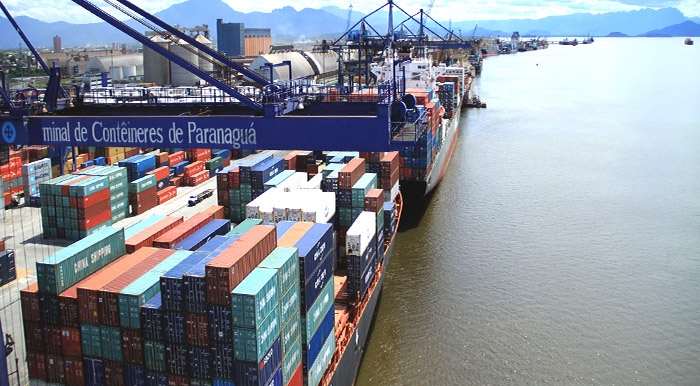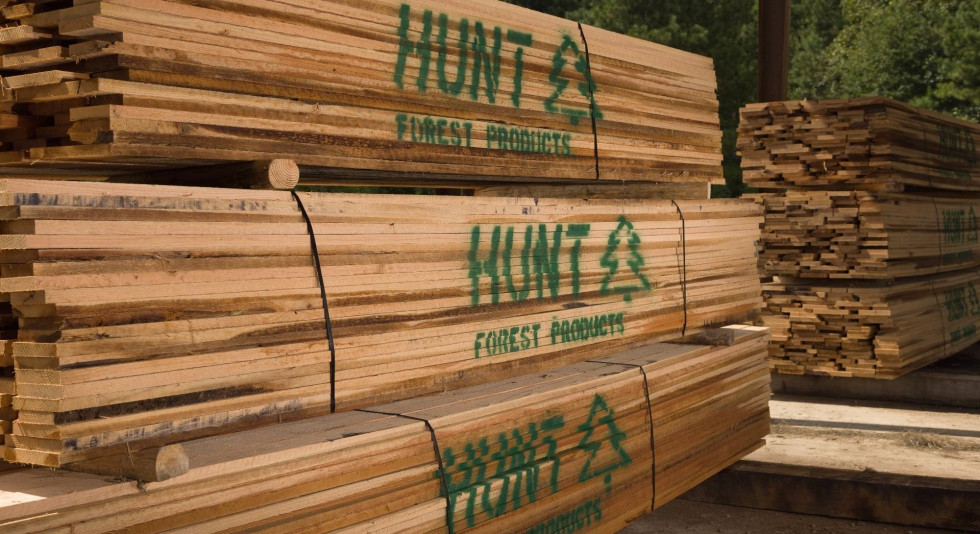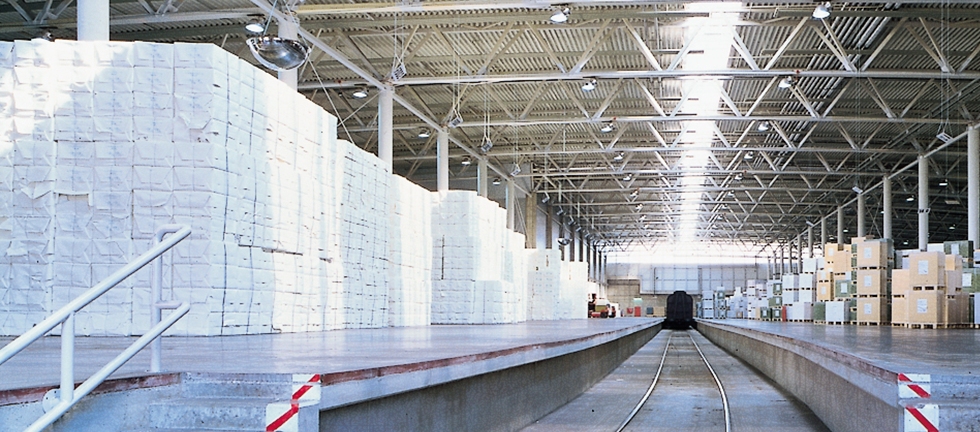|

Klabin Begins Construction of New Pulp Terminal at Port of Paranaguá, Brazil
Aug. 10, 2021 – Klabin, Brazil’s largest paper manufacturer and exporter and the country’s leading producer of papers and paperboard for packaging, has started construction on its new terminal on the quay of the Port of Paranaguá, following the signing of the permit in July by the Port of Paraná. In this phase, the project is expected to create 180 new jobs.
Once the terminal starts commercial operations, it will require around 170 direct and indirect employees.
“This location on a primary site will further streamline our pulp and pulp byproduct operations,” said Luiz Fernando Garcia, CEO of Parana Ports. “It represents an important investment in the state’s port infrastructure that will create new jobs and generate income for the coastal region.”
In addition to acquiring equipment and operational systems, a two-kilometer rail branch and a 21,860 square metre warehouse will be built. The investments, which is estimated to total R$130 million, are slated for 2022.
The concession to operate area PAR01, with 27,530 sq.m, was won by Klabin in an auction held in August 2019. The signing of the concession contract, in early 2020, effectively ended two decades without any new concessions granted at the Port of Paranaguá.
The concession contract is for 25 years and may be renewed for another 45 years.
“We’re thrilled to be starting construction on the new terminal, which will follow all safety and health protocols,” said Sandro Ávila, director of Operating Planning, Logistics and Procurement at Klabin. “This is a very important project for the company that will make a big social and economic contribution to Paranaguá,” he added.
In its first year of operations, the company expects to move 1.4 million tons through the port. Once the second phase of expansion of the Klabin Unit in Ortigueira (Puma II Project) is concluded, which is slated for 2023, the company expects to move 2.2 million tons per year through Paranaguá.
In line with its commitment to fostering the development of local communities, Klabin also is making important social investments in the city. These include the Public Administration Support Program, which offers administrators (mayors, municipal secretaries and their teams) techniques in public administration and the tools for planning and monitoring actions, effectively leveraging their control of the actions planned and executed by municipal governments.
Klabin also will implement all conditions for the Neighborhood Impact Study (EIV), which envisages the construction of an exclusive pedestrian overpass spanning the main rail crossing, which will benefit around 2,800 workers per day, ensure safer access to the port, and also generate benefits in the social arena, which include environmental education programs at schools.
SOURCE: Klabin |
|
|

Hunt Forest Products and Tolko Industries to Build New $240 Million Sawmill in Northwest Louisiana
July 26, 2021 - Hunt Forest Products and Tolko Industries Ltd. today announced that they will build a $240 million, state-of-the-art sawmill in Bienville Parish, near Taylor, Louisiana. Construction is expected to start in early 2022, and the new facility will employ approximately 60 people when operations begin in the first half of 2023.
The sawmill will employ approximately 130 people when it is operating at full capacity.
“We are excited to be bringing our second high-tech sawmill, and the skilled jobs it will provide, to Louisiana, and to provide a local outlet for the massive inventory of southern yellow pine that exists in this state,” said James D. Hunt, co-owner and vice chairman of the Board of Directors of Hunt Forest Products.
The mill will prioritize buying timber locally, and it is estimated that the mill will require approximately 1.3 million tons of wood annually to produce approximately 320 million board feet of lumber annually, Hunt said. The facility will be located on approximately 255 acres of land including the existing Taylor sawmill site and some adjacent timber land.
Louisiana Governor John Bel Edwards said the state strongly supports the project and is particularly pleased that the facility will be in Bienville Parish.
“This project is a great economic boost to the northwest part of the state, strategically located to have access to the heart of our historic timber industry, and it will help create hundreds of direct and indirect jobs across the construction, forestry, industrial services, and retail sectors in the town of Taylor and in Bienville Parish,” Edwards said.
Edwards also said that the Louisiana Department of Economic Development will be using the state’s nationally recognized LED FastStart® workforce development program, in coordination with Bossier Parish Community College (BPPC), to build and train the local skilled workforce the new state-of-the-art sawmill will need.
The new sawmill project is a joint venture between Hunt Forest Products and Tolko, a 60-year old family-owned Canadian forestry industry company that produces a wide range of forest products for customers around the world. Tolko, based in Vernon, British Columbia, partnered with Hunt Forest Products to build a modern sawmill in Urania, Louisiana that began operations in 2018.
Similar to the Urania sawmill, Tolko will own a 50 percent share, and the mill will be managed and operated by Hunt on a day-to-day basis.
“Our first venture into the United States was in partnership with Hunt Forest Products, a family-owned company like ours, and that has been very successful,” said Brad Thorlakson, Tolko President and CEO. “So, we are looking forward to working with the Hunt family again to bring another state-of-the-art sawmill, and jobs, to Louisiana.”
SOURCE: Hunt Forest Products |
PPI Transport Symposium 24 - Early Bird Registration Remains Available
 July 2021 - There is still time to take advantage of early bird rates for the PPI Transport Symposium 24 to be held September 14-16, 2021 at the Sawgrass Marriott Resort and Spa in Jacksonville, Florida. July 2021 - There is still time to take advantage of early bird rates for the PPI Transport Symposium 24 to be held September 14-16, 2021 at the Sawgrass Marriott Resort and Spa in Jacksonville, Florida.
Organized by Fastmarkets RISI, in association with the International Forest Products Transport Association (IFPTA), this event focuses on trending topics in worldwide transport, materials handling, and distribution of forest products.
Are you a member of IFPTA? Members of IFPTA will automatically receive a significant discount when registering for the event.
The conference registration fee covers participation in all conference sessions, JAXPORT tour, access to exhibit hall, cocktail receptions on September 14 and 15, lunch on September 15 and 16, networking breaks, and a copy of the conference proceedings.
Don’t miss three days of unforgettable learning and networking experiences. Learn more about PPI Transport Symposium 24 and registration for the event here |
|

Sappi Invests in Fully Transparent, Customer Centric Supply Chain in Partnership with Shippeo
July 2, 2021 - Sappi Europe, the leading European producer of coated graphic paper and packaging and speciality papers, has partnered with Shippeo, the European leader in real-time transportation visibility solutions. This partnership will create a fully transparent supply chain helping to boost efficiency and customer satisfaction through innovative digital supply chain capabilities.
Sappi Europe employs 5,600 people across the region producing 3.7 million tons of paper and 1.12 million tons of paper pulp each year across ten mills. Sappi Europe is part of South Africa-based Sappi Limited one of the leading global providers of pulp, paper, packing and sustainable woodfibre products and solutions. This partnership with Shippeo will see real-time visibility incorporated into internal transportation and last leg customer deliveries across the continent.
There is an ongoing need for supply chain cost reduction, greater customer focus with higher service levels. Digitizing processes in the supply chain is therefore a key focus area. Being able to provide real time delivery updates will increase internal efficiencies and improve overall customer service.
Shippeo’s solution offers “predictive visibility” of supply chain transportation, enhancing the customer experience by providing a reliable estimate of when an order will arrive with the customer as well as a faster response to customer inquiries on goods in transit. Proactive sharing of the live delivery status with customers ensures early warnings are given on potential delivery delays.
In addition to facilitating a better customer experience, the improved transparency across its supply chain network will enable Sappi to achieve considerable improvements in efficiency. The company will now be able to measure and manage carrier performance in real-time, as well as benefit from faster and more efficient information exchange and communication between customer service, logistics and carrier teams. Insights drawn from resulting data will also help to drive continuous improvement of operational processes.
“Our customers rely on the timely delivery of our high-quality products to accommodate their production processes,” says Rudi Barthels, Head of Supply Chain & Procurement Projects, Sappi Europe, adding that “by collaborating with Shippeo and our transportation partners, we aim to exceed our customers’ expectations by offering a predictable consistent and reliable delivery experience.”
Dennis van Bodegom, Director Shippeo Northern Europe, is thrilled to welcome Sappi Europe into the Shippeo community. “Like many industries, the luxury paper and woodfibre sector is increasingly moving towards just-in-time deliveries. This means the logistics and communication is key, both for Sappi’s customers and for the customer service managers, who are used to getting customer inquiries around deliveries. I’m confident that our cooperation will lead to an optimised and proactive supply chain, for the benefit of Sappi as well as their partners and customers.”
SOURCE: Sappi |
|

Red Leaf Pulp to Build $350 Million Wheat Straw Pulp Mill in Regina, Saskatchewan
June 3, 2021 - Red Leaf Pulp Ltd., developer of a proprietary wheat straw-based pulp mill, announced that it will locate its initial facility in Regina, Saskatchewan, Canada. The company has secured properties on the west side of the City of Regina and will begin construction of the $350 million facility in early 2022.
The initial plant will have the capacity to produce approximately 182,000 tonnes of market pulp annually from waste wheat straw collected and aggregated from local producers.
According to Red Leaf, the new facility is expected to create 110 permanent full-time jobs, and 250 jobs during construction.
"Red Leaf is delighted to be locating in Regina and we look forward to working with the community, local businesses and the region's growers. Our project provides an opportunity to enhance the utilization of existing resources and diversify revenue sources in the ag-industry while creating a lower carbon future." said Martin Pudlas, CEO of Red Leaf Pulp.
"We want to thank communities across Saskatchewan for their support, interest and assistance during the location evaluation process. Ultimately Regina's proximity to major infrastructure and a significant workforce were key considerations in our choice for the initial plant site," Pudlas said.
Regina Mayor Sandra Masters commented, "I am very pleased Red Leaf has chosen to locate Canada's first non-wood pulp mill in Regina. This facility allows our City continued diversified growth in the urban-agricultural economy. It will highlight innovation in one of our core industries, maximize crop value in an environmentally sustainable way and provide valuable jobs in the low carbon energy sector. This is exciting news for Regina and our Province."
John Lee, CEO of Economic Development Regina, added, "More than ever, Regina is becoming the epicentre of a sustainable, value-added agriculture economy. We're proud to have worked closely with Red Leaf throughout this process and we are excited to welcome them to the region. Red Leaf's announcement means new jobs for Regina citizens and new opportunities for Regina businesses."
About Red Leaf Pulp Ltd.
Red Leaf Pulp is developing the first non-wood pulp mill in Canada, producing a unique unbleached product. Red Leaf was established in 2019 by Darby Kreitz, the founder of Allnorth Consultants, a 500-person engineering firm with offices across Canada and in Atlanta, Georgia. Allnorth has significant experience in the design and commissioning of non-wood pulp mills in the United States and Europe, in addition to 26 years providing engineering services to the conventional wood pulp and paper industry. To learn more, visit: www.redleafpulp.com.
SOURCE: Red Leaf Pulp Ltd. |
|
|